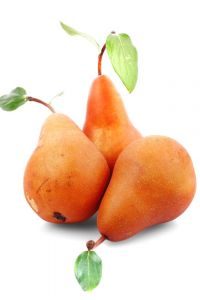Compliments of Mother Nature & Your Favorite Fruit of the Month Club!
TAYLOR’S GOLD PEARS — The Taylor’s Gold pear is a mutation of the Comice Pear, first discovered in New Zealand in 1986. This sweet and flavorful russet pear is available in limited quantities in some markets. Enjoy this particularly juicy pear fresh or sliced, and add to a variety of salads and recipes. Taylor’s Golds are especially complemented served with soft ripening cheeses like Brie, Camembert, or any of the blues.
Ripening: Color is not a good indicator in determining ripeness in the Taylor’s Gold pear, though they will appear slightly more golden when ripe. Check for ripeness by gentle pressure applied near the stem end. When the fruit gives slightly, it is ready to be eaten. Ripe pears can be stored in the refrigerator for up to 4 days.
Blueberry & Taylor’s Gold Pear Waldorf Salad

1 c. fresh or thawed frozen blueberries, divided
1/4 c. vegetable oil
2 T. orange marmalade
2 t. lemon juice
1 t. Dijon mustard
1/4 t. salt
4 c. (about 4 ounces) baby spinach
1 Taylor’s Gold pear, peeled, cored and thinly sliced
2 ribs celery, cut into 1-1/2 inch matchsticks (about 1 cup)
1/2 c. pecan or walnut halves, toasted
In a blender, prepare the dressing by combining 1/2 c. of the blueberries, oil, marmalade, lemon juice, mustard and salt. Blend until a smooth, thick dressing forms. In a bowl, toss the spinach with pear slices, celery, pecans and remaining 1/2 cup blueberries. Arrange equally on four serving plates. Just before serving, blend the dressing again until smooth; drizzle over the salads, and serve immediately. Makes four generous servings.
Nutrition Facts: Pears are excellent sources of dietary fiber, vitamin C and potassium. They are fat free, sodium free, and contain no cholesterol!
MANGOS — The mango has been grown in Southeast Asia for more than 4,000 years. Mango groves have spread to many parts of the tropical and sub-tropical world, anywhere the climate allows the mango to take root. This fruit is an excellent source of vitamins A and C, as well as a good source of potassium and contains beta carotene. It adds a wonderful tropical flavor to fruit salads, green salads, smoothies and relishes, not to mention the pleasure to be had from eating one out of hand.
How do you slice a Mango? Stand the Mango stem down on your cutting board, and hold it firmly. Placing the knife about 1/4″ from the widest center line, cut down along the seed. Repeat this cut on the other side. The resulting ovals of mango flesh are known as “the cheeks.” (What is left in the middle is mostly the large, oval mango seed.) Cut parallel slices into the flesh of the Mango cheeks, being careful not to cut through the skin. Turn the sliced “cheek” inside-out by pushing the skin up from beneath. Scrape the mango slices off the skin using a knife or spoon.
Ripening & Storage: They are ready to enjoy when slightly soft to the touch and when they yield to gentle pressure, like a peach. Ripen mangos at room temperature. To speed ripening, place in a paper bag overnight. A ripe mango can be refrigerated for a few days.
Mango Chicken Salad
4 (4 oz. each) boneless, skinless chicken breast halves
Teriyaki marinade (store bought kind is fine)
2 T. finely chopped crystallized ginger
1/3 c. vegetable oil
3 T. orange juice concentrate
2 T. unseasoned rice vinegar
2 T. water
6 c. arugula & mixed baby greens
2 mangos, peeled, seeded & sliced
1/2 small red onion, very thinly sliced
Cilantro leaves
Marinate chicken in teriyaki for 1 to 8 hours in the refrigerator. Grill chicken. Prepare dressing by whisking next 5 ingredients together in a small bowl. Just prior to serving, place the greens in a large shallow bowl. Toss with half of the dressing. Cut chicken across the grain into slices and spread over the greens. Top salad with mango slices, onion and cilantro leaves. Drizzle the remaining dressing and serve. (Chicken may be warm or cool — this salad is wonderful either way.)